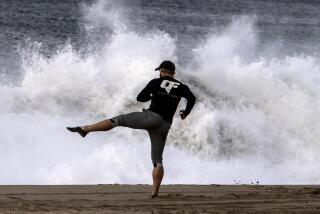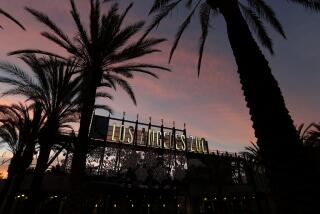Enjoying nature during the shutdown is easy — but only if you’re rich

- Share via
Up a suburban cul de sac a police car prowls, looking for hikers. Down below, immigrant men stand around with no place to go. Marin County, which has 143,000 acres of public lands and 258,000 citizens, has issued an order declaring that anyone driving to parks “for the purpose of accessing that facility… constitutes an imminent threat and menace to public health, constitutes a public nuisance, and is punishable by fine, imprisonment, or both.”
The fight for access to open space and natural landscapes has a long history, and it’s taken a new turn in the pandemic.
“Avoid gatherings stay home save lives,” says a big flashing light board on Highway 101 just north of the Golden Gate Bridge. But not staying home can be the opposite of gathering; it can be dispersing, and recent studies suggest that the risk of transmission outside is quite low. People enjoying nature, while remaining at a distance from everyone who’s not in their household and doing it not too far from home, pose little public health risk.
Throughout California, emergency orders have allowed people to leave their homes for essential activities, including exercise. But what’s outside each of our front doors varies. A lot.
I respect the efforts taken to prevent people from crowding well-known beaches and other public spaces and from creating work that could put park rangers and maintenance people at risk, and I know that small towns from the California coast to the eastern Sierra have been hard hit by people swarming their grocery stores and otherwise stressing their local resources. I agree we should stay local. The question is how local.
Marin County has closed parking lots and parks and posted signs at trailheads in residential zones that state, “All individuals are expected to remain local when enjoying the outdoors.” But in one of that county’s poorest neighborhoods, the poet Javier Zamora, who grew up there, reported, “The local park, Pickleweed Park is officially shut down. The park served as a meeting place of sorts for people who live in crowded apartments (read: immigrant men who may cram 6 to 7 people in a 1 bedroom apartment they mostly use to sleep in).” He told me his aunts, who still live in the old neighborhood, report that with the park closed, the men, many of them out of work, have no place to go and just stand around by their buildings much of the day. That’s remaining local; it’s not enjoying the outdoors. Walking out the front door, we’re still not equal, if yours opens onto glorious, open parkland and mine onto a spaghetti bowl of freeways or an industrial wasteland. Sonoma County has similar regulations, and a Santa Rosa woman told me the parks she can walk to are not safe, in her view.
We’re dealing with three disasters right now, not one. The first is a pandemic. The second is a financial catastrophe. The third, just swimming into sight right now, is what gets called a mental health crisis but maybe should be called an emotional and spiritual crisis instead. A lot of depression, grief, loss, disorientation, exhaustion, stress, fear and loneliness are welling up all around us. The data are already in that exercise is good for depression, and that nature and natural landscapes provide solace, hope, reassurance, perspective and encouragement for a lot of people.
Not long after the 2008 economic crash, a Midwestern woman told me that part of how she weathered the crisis was by driving to the shore of one of the Great Lakes every day to put her woes in the context of that vastness. Last month, San Francisco doctor C. Dale Young described how, driving home from his hospital exhausted, he had wept onto his mask and begged a park ranger barring his way to let him see the ocean. “I go to it when I need to think through difficult things. It has always helped me,” he wrote. In the long run, we should think of access to nature and open space as human rights and health issues and recognize how unequal that access has always been.
In the short run, we should think about how to meet that need and those rights in this crisis. I am not suggesting undermining the stay-at-home order or dismissing the need for it. On the contrary, the more humane we make it, the more people will comply with it, and the longer it goes, the more we need to recognize emotional and spiritual needs as among what many county orders define as “essential needs,” when they do not conflict with the stay-separate mandate.
Katy Butler, a Mill Valley resident, recently pointed out that what worked during the AIDS crisis wasn’t asking gay men to give up sex; it was asking them (and everyone else) to practice safer sex. She believes the same principle should apply to access to nature today.
When affluent counties like Marin insist that no one should drive to green space, that effectively bars many people from access to nature. San Mateo County has asked people not to drive more than five miles, which seems like an ideal balance between keeping people from converging on popular well-known spots and acknowledging that not everyone has access to tolerable space to walk in out their front door nor the muscle to reach distant open space on foot or bike.
Local should include green space for everyone, and California has always been a place with unequal access. Nowhere is this more apparent than in Los Angeles, with its notorious lack of public parks in poorer parts of the city and endless open space up the canyons and on the edges. But throughout the state, we have unequal access to nature and open space, and making it more unequal in the pandemic does not serve a public health interest. If it’s safe for the software baron in the mansion up on the mountain to hit a trail, it’s safe for the grocery cashier and her kids in the apartment down below to get onto it too.
Rebecca Solnit is the author of numerous books, including, most recently, “Recollections of My Nonexistence.”
More to Read
A cure for the common opinion
Get thought-provoking perspectives with our weekly newsletter.
You may occasionally receive promotional content from the Los Angeles Times.









